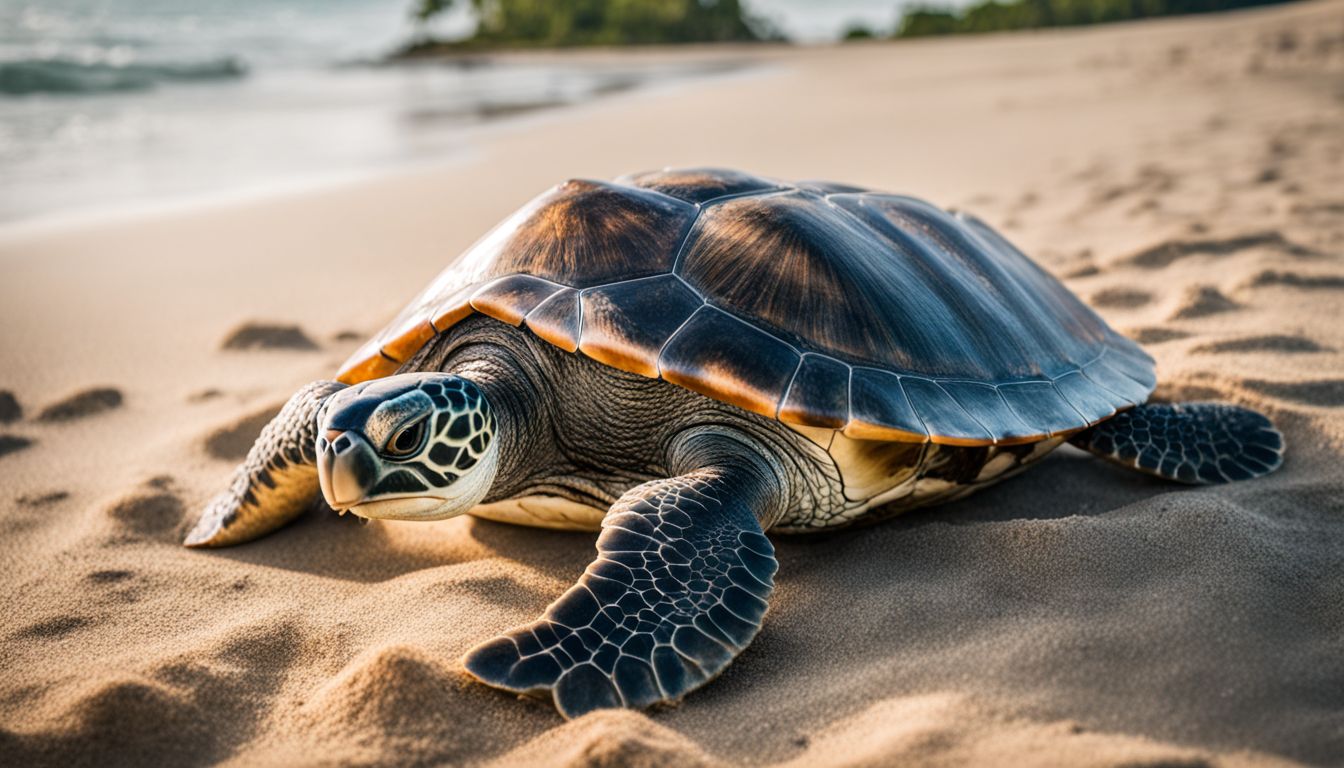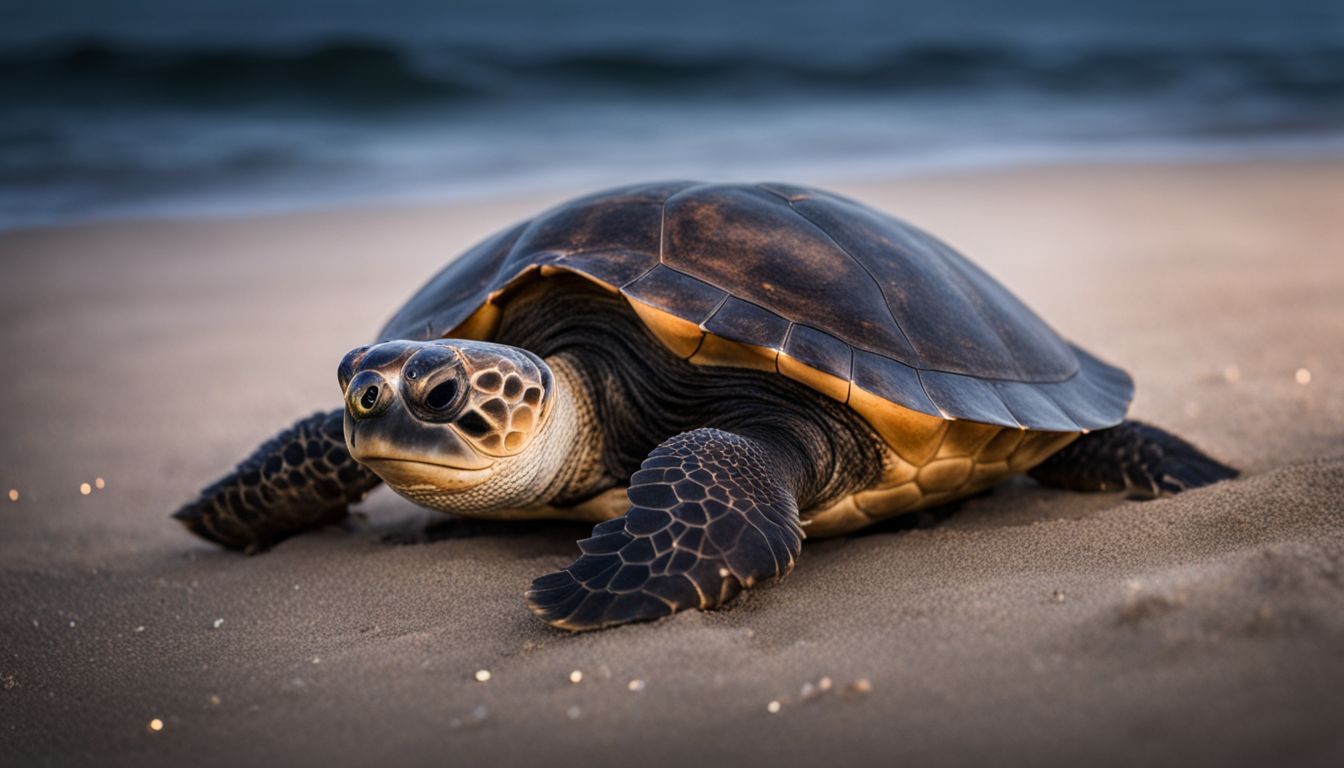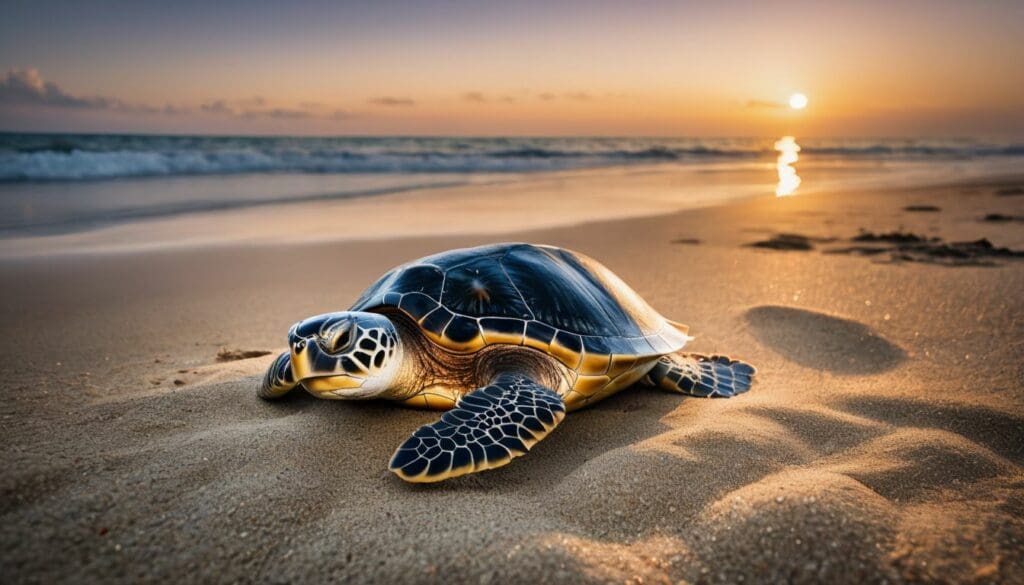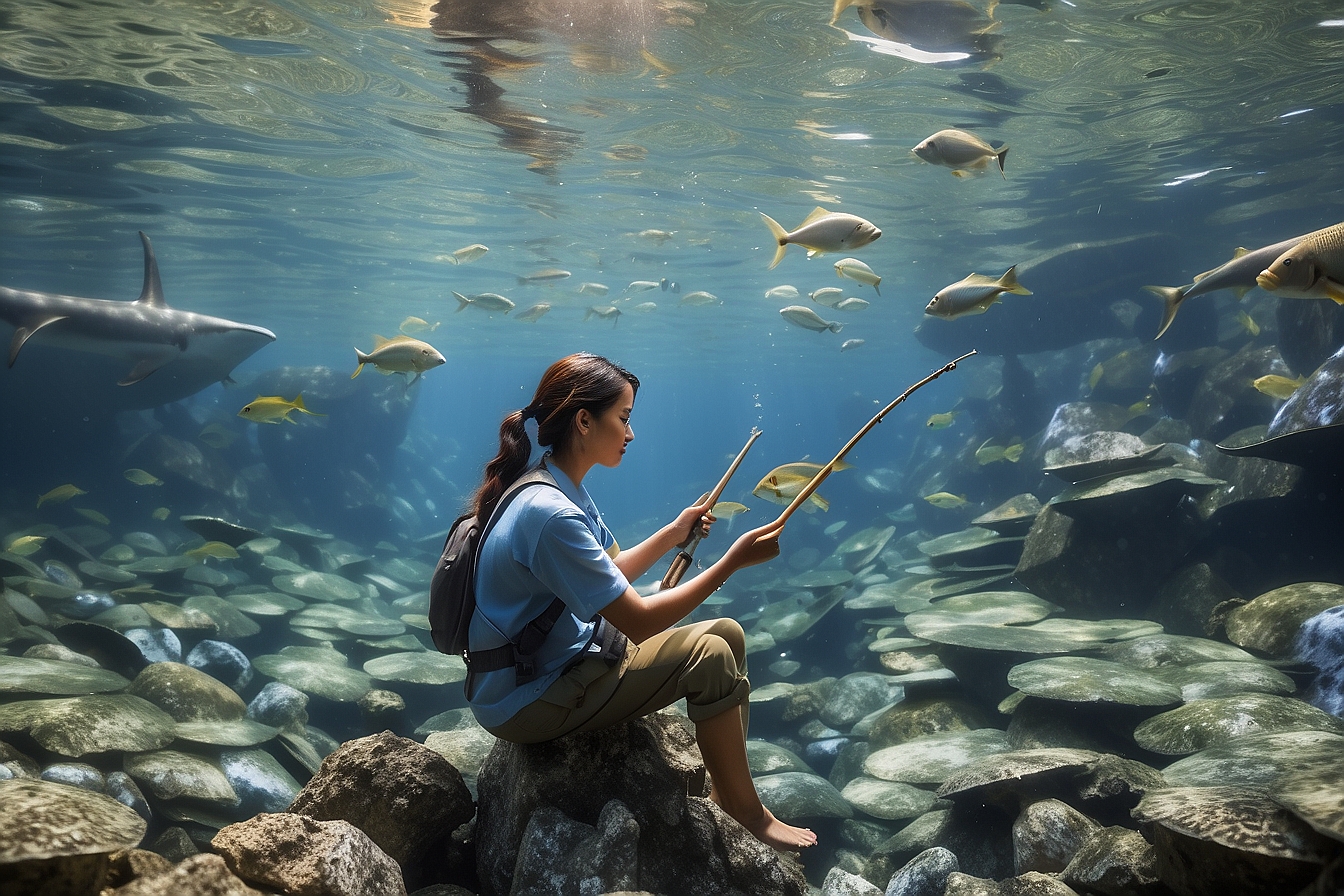It’s all too easy to overlook the spellbinding spectacle that graces our shores each year. Like many of us, you may have stumbled upon traces of sea turtles during a beach stroll, your curiosity piqued by these enigmatic ocean wanderers.
Delving into their hidden lives has unveiled a remarkable fact: up to 800,000 green turtle nests can be recorded in a single season—a striking affirmation of nature’s relentless vitality and splendour.
Join us as we delve into the enchanting world of turtle nesting rituals; it is indeed a narrative woven with wonder that simply demands our attention.
Key Takeaways
- Sea turtles have distinct nesting seasons depending on the species, with leatherback turtles starting as early as February and green turtles around June. They return to their birthplaces to lay eggs, engaging in critical rituals for their survival.
- Conservation efforts at places like Accra Beach and Archer’s Bay are key; local patrol teams protect nests from predators and human threats, ensuring hatchlings stand a better chance of making it to the sea.
- Guided turtle tours teach visitors about these creatures’ life cycles and how not to disturb them while contributing financially to conservation projects. These tours encourage responsible enjoyment of natural spectacles which supports ongoing protection efforts.
- Individual actions can significantly support sea turtle conservation through beach clean – ups, adopting a turtle, volunteering with local organisations, reducing light pollution near nesting sites, advocating for habitat protection policies, respecting nest barriers at beaches like Caswell Beach or Topsail Island, and sharing wildlife rescue contacts.
- Green sea turtles are vital for maintaining healthy seagrass beds in ecosystems such as Graeme Hall Nature Sanctuary where they find refuge during nesting season. Our role includes minimising disturbance so females can safely lay their eggs.
Understanding Turtle Nesting Seasons and Habits

Sea turtles follow annual cycles, returning to lay their eggs on the same beaches where they were born. These periods are crucial for their survival and differ among species. Leatherbacks often begin nesting as early as February, while loggerheads typically wait until May to start.
We find green turtles making their way to shores around June. They dig out nests with their flippers, carefully laying and covering eggs before heading back into the ocean.
Each of these precious creatures has a unique approach during nesting season. Hawksbill turtles choose secluded beaches fringed by coral reefs, safeguarding their young from predators.
Nest monitoring becomes vital at this time, ensuring that we protect both nests and hatchlings from threats like plastic pollution or beach erosion. By keeping watchful eyes on these sites and reducing human interference, we can give sea turtle conservation a helping hand during these critical months.
Highlight on Turtle Species and their Nesting Sites

As we delve into the remarkable world of marine turtles, let’s explore the diverse species and their chosen sanctuaries where they perform their ancestral nesting rituals. Witness how each species selects its unique beachside theatre, setting a stage for one of nature’s most breathtaking spectacles.
Hawksbill Turtles at Accra Beach
Hawksbill turtles grace the shores of Accra Beach with their presence, usually under the cover of darkness. These incredible marine turtles are known for their distinctive patterned shells and make an extraordinary journey back to their birthplace to lay eggs.
We often stand in awe as they meticulously dig nests in the soft sand, a ritual vital for their survival.
We find ourselves deeply committed to safeguarding these endangered species that depend on both land and sea environments. At Accra Beach, efforts by local turtle patrol teams help ensure hawksbill hatchlings have a fighting chance against natural predators and human interference.
By working together with conservationists, we play a crucial role in protecting these majestic creatures and maintaining the delicate balance of our marine ecosystems.
Leatherback Turtles at Archer’s Bay
Archer’s Bay is a serene backdrop for the awe-inspiring journey of leatherback turtles. Each nesting season, these magnificent creatures lumber ashore with an ancient rhythm etched into their movements.
We watch in hushed admiration as they dig their nests and lay their eggs under the moon’s watchful eye. The largest of all sea turtles, leatherbacks have a distinct appearance with leathery shells and powerful flippers paddling through the waves.
Their presence at Archer’s Bay adds to our tapestry of marine biodiversity, drawing us closer to understanding these gentle giants of the ocean. Conservation measures here work tirelessly, ensuring that each nest is a safe haven for future hatchlings.
As we stand guard over these vulnerable sites, we’re reminded that our respect and action can help secure their legacy for generations to come.
Moving from the rugged shores graced by leatherbacks, let’s turn our attention towards another critical sanctuary – the lush haven where Green Sea Turtles find refuge at Graeme Hall Nature Sanctuary.
Green Sea Turtles at Graeme Hall Nature Sanctuary
At Graeme Hall Nature Sanctuary, we find green sea turtles thriving in a rare haven of biodiversity. These marine giants glide through the water with an elegance that belies their size, making for a mesmerising sight.
Ensconced within this protected environment, they forage on seagrass and algae, vital components of their diet which help maintain healthy seagrass beds and contribute to the complex ecosystem here.
Our team closely monitors these gentle reptiles during nesting season. We ensure minimal human disturbance so each female can safely lay her eggs on the sanctuary’s nurturing shores.
Protecting these endangered creatures is paramount; our efforts directly support broader conservation initiatives across beachfronts globally.
As night descends and stars pepper the sky, it’s not just about safeguarding nests but preserving a future where every hatchling has a fighting chance. Now let us turn our attention to how patrols and guided tours are shaping sustainable turtle watching practices along these precious coastlines.
The Role of Conservation Efforts in Protecting Turtle Nesting
We play a crucial role in safeguarding the future of sea turtles through dedicated conservation efforts. Our actions help protect beaches where loggerhead and Kemp’s ridley turtles come to nest, ensuring they remain safe and undisturbed by human interference.
We work to maintain healthy seagrass beds, which are vital for marine organisms like the green sea turtle that depend on them for food.
By collaborating with groups such as the Sea Turtle Conservancy, we assist in monitoring and securing nesting sites at critical locations like Florida beaches and Wassaw Island. Setting up protective barriers around nests prevents predators from plundering eggs, while beach renourishment projects restore eroded shorelines, giving turtles ample space to lay their eggs.
Our collective vigilance allows these ancient mariners to continue their timeless dance of life unimpeded on the sands they have visited for millennia.
Guided Tours: A Sustainable Way to Experience the Phenomenon
Building on the importance of conservation, guided tours offer a unique opportunity to witness sea turtle nesting safely and sustainably. These educational excursions are carefully designed to protect the turtles while providing an unforgettable experience.
- Understand the Life Cycle: Guides explain the fascinating life cycle of sea turtles, from hatchling to adulthood. This knowledge deepens appreciation for these creatures and the urgent need to protect them.
- Spotting Without Disturbing: Tourists learn how to spot nesting sea turtles without disturbing them, using red lights that don’t disorient the turtles or impede their natural behaviors.
- Learning About Threats: Educators discuss the various threats facing sea turtles, such as coastal development and ocean pollution. Awareness is key to driving change and supporting conservation efforts.
- Supporting Conservation: Each tour contributes directly to conservation projects. Participating in these tours means your money helps fund vital research and protection programs.
- Eco-Friendly Practices: Tour groups keep beaches clean, stick to designated paths, and follow strict guidelines ensuring minimal impact on the environment.
- Witnessing Miracles Responsibly: Visitors get a chance to see hatchlings make their way to the ocean—if they’re lucky—creating powerful memories while respecting nature’s delicate balance.
How to Support Sea Turtle Conservation
We can each play a vital role in conserving the habitats and lives of sea turtles. Here are actionable ways we can help these majestic creatures survive and thrive:
- Participate in beach clean – ups to maintain a safe environment for turtle nesting. Remove litter that could entangle or harm turtles and their hatchlings on beaches like Caswell Beach or Topsail Island.
- Adopt a turtle through conservation programmes such as Mote Marine Laboratory, allowing your funds to directly support research and protection initiatives.
- Volunteer with local conservation networks, contributing time to monitor nests, guide hatchlings safely to the sea, or engage in turtle talks to educate the public.
- Reduce light pollution near nesting sites like Wassaw National Wildlife Refuge by using turtle-friendly lighting or simply turning off unnecessary lights at night.
- Support laws that protect sea turtle habitats; advocate for policies that preserve seashores and ban activities detrimental to nesters’ survival.
- Avoid disturbing marked turtle nests, respecting barriers and signs placed there by groups like the Clearwater Marine Aquarium network.
- Inform others about the importance of sea grass preservation, which provides crucial feeding areas for species such as the green sea turtle.
- Share contact details of wildlife rescue organisations so anyone can report injured turtles immediately – keeping an email address or phone number handy could save a life.
Conclusion
As the sun dips below the horizon, a new day dawns for sea turtle hatchlings. They embark on a perilous journey, guided by moonlight to the ocean’s embrace. Our awe at this beachside miracle grows with each tiny flipper’s imprint in the sand.
Let’s carry this wonder into action to safeguard these ancient mariners for generations to come. Together, we make each nesting season a hopeful promise to our planet’s future.
FAQs
1. What are turtle nesting rituals?
Turtle nesting rituals involve loggerhead sea turtles, and other species like Kemp’s ridley, making their way to beaches like those in Oak Island or Cape Hatteras to lay eggs.
2. Where do loggerhead turtles nest?
Loggerhead turtles nest on sandy beaches along the Southwest Atlantic, including places such as Florida’s coasts and Pacific regions where the conditions suit their nesting habits.
3. How can we learn about turtle nesting at Oak Island?
To understand more about turtle nesting at Oak Island, you can follow electronic communications from wildlife experts or visit during the nesting season for educational tours.
4. Why is it important to protect turtle nests?
It’s crucial to protect turtle nests because these sites ensure the survival of endangered species like Kemp’s ridley turtles by providing a safe space for their young until they hatch and reach the ocean.





